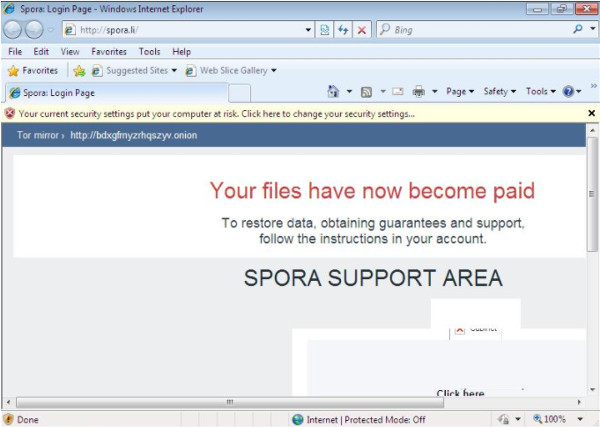RANSOM_SPORA.THEAH
Trojan-Ransom.Win32.Spora.dpf(Kaspersky);Ransom.Spora(Norton);Ransom-Spora.b(NAI)
Windows


Threat Type: Ransomware
Destructiveness: No
Encrypted: Yes
In the wild: Yes
OVERVIEW
This Ransomware arrives on a system as a file dropped by other malware or as a file downloaded unknowingly by users when visiting malicious sites.
It modifies Internet Explorer security settings. This puts the affected computer at greater risk, as it allows malicious URLs to be accessed by the computer.
It encrypts files with specific file extensions. It drops files as ransom note.
TECHNICAL DETAILS
Arrival Details
This Ransomware arrives on a system as a file dropped by other malware or as a file downloaded unknowingly by users when visiting malicious sites.
Installation
This Ransomware drops the following files:
- %Application Data%\Xkj1VYCu
(Note: %Application Data% is the Application Data folder, where it usually is C:\Documents and Settings\{user name}\Application Data on Windows 2000, Windows Server 2003, and Windows XP (32- and 64-bit); C:\Users\{user name}\AppData\Roaming on Windows Vista (32- and 64-bit), Windows 7 (32- and 64-bit), Windows 8 (32- and 64-bit), Windows 8.1 (32- and 64-bit), Windows Server 2008, and Windows Server 2012.)
It adds the following mutexes to ensure that only one of its copies runs at any one time:
- Xkj1VYCu
Web Browser Home Page and Search Page Modification
This Ransomware modifies Internet Explorer zone settings.
Other Details
This Ransomware does the following:
- Execute the following command:
- vssadmin.exe delete shadows /quiet /all
- Display the following ransom note(from the url {BLOCKED}.{BLOCKED}.19.190 ):

Ransomware Routine
This Ransomware encrypts files with the following extensions:
- .bak
- .sql
- .backup
- .7z
- .rar
- .zip
- .tiff
- .jpeg
- .jpg
- .accdb
- .sqlite
- .dbf
- .1cd
- .mdb
- .cd
- .cdr
- .dwg
- .psd
- .pptx
- .ppt
- .odt
- .rtf
- .docx
- .xlsx
- .doc
- .xls
It avoids encrypting files found in the following folders:
- windows
- program files
- program files (x86)
- games
- appdata
It drops the following file(s) as ransom note:
- {Encrypted File Directory}\HELP_Xkj1VYCu.html
- %User Startup%\HELP_Xkj1VYCu.html
(Note: %User Startup% is the current user's Startup folder, which is usually C:\Documents and Settings\{user}\Start Menu\Programs\Startup on Windows 2000 and XP, and C:\Documents and Settings\{User name}\Start Menu\Programs\Startup on Windows Vista, 7, and 8.)
SOLUTION
Step 1
Before doing any scans, Windows XP, Windows Vista, and Windows 7 users must disable System Restore to allow full scanning of their computers.
Step 2
Note that not all files, folders, and registry keys and entries are installed on your computer during this malware's/spyware's/grayware's execution. This may be due to incomplete installation or other operating system conditions. If you do not find the same files/folders/registry information, please proceed to the next step.
Step 3
Search and delete this file
- %Application Data%\Xkj1VYCu
- {Encrypted File Directory}\HELP_Xkj1VYCu.html
- %User Startup%\HELP_Xkj1VYCu.html
Step 4
Scan your computer with your Trend Micro product to delete files detected as RANSOM_SPORA.THEAH. If the detected files have already been cleaned, deleted, or quarantined by your Trend Micro product, no further step is required. You may opt to simply delete the quarantined files. Please check this Knowledge Base page for more information.
Step 5
Reset Internet security settings
Step 6
Restore encrypted files from backup.
Did this description help? Tell us how we did.

